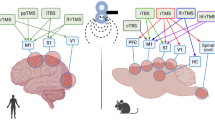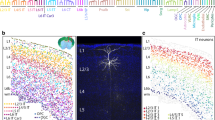Abstract
Objective
There is substantial evidence supporting the notion that the anterior cingulate cortex (ACC) is an important limbic structure involved in multiple brain functions such as sensory perception, motor conflict monitoring, memory, emotion and cognition. It has been shown that long term potentiation (LTP) is an important synaptic model of neural plasticity in the ACC, however, little is known about the spatiotemporal properties of ACC at network level. The present study was designed to see the LTP induction effects across different layers of the ACC by using different conditioning stimuli (CS) protocols.
Methods
A unique multi-electrode array recording technique was used in the acutely-dissociated ACC slices of rats. Long and short train theta burst stimulation (TBS) paradigms were applied in layer V–VI as the CS and the LTP induction effects were compared across different layers of the ACC. Briefly, both long and short train TBS are composed of bursts (4 pulses at 100 Hz) with a 200 ms interval, however, the former (TBS1) was with 10 trains and the latter (TBS2) was with 5 trains. After test stimulation at layer V–VI in the ACC, network field potentials (FPs) could be simultaneously recorded across all layers of the ACC.
Results
The waveforms of FPs were different across different layers. Namely, positive-going waveforms were recorded in layer I and negative-going waveforms were recorded in layers V–VI, in contrast, complex waveforms were localized mainly in layers II–III. Following application of two CS protocols, the induction rate of LTP was significantly different between TBS1 and TBS2 regardless of the spatial properties. TBS1 had more than 60% success, while TBS2 was less than 25% in induction of LTP. Moreover, both the 2 CS protocols could induce LTP in layers II–III and layers V–VI without layer-related difference. However, no LTP was inducible in layer I.
Conclusion
The present findings indicate that stimulation protocols may, at least in part, account for a large portion of variations among previous LTP studies, and hence highlight the importance of selecting the best LTP induction protocol when designing such experiments. Moreover, the present results demonstrate the prominent superiority of multi-electrode array recording in revealing the network properties of synaptic activities in the ACC, especially in comparing the spatiotemporal characteristics between different layers of this structure.
摘要
目的
大量研究显示前扣带回(anterior cingulate cortex, ACC)是一个多功能的边缘系统结构, 参与诸如知觉, 运动, 情绪和认知等多种高级脑功能。 有证据显示长时程增强现象(long-term potentiation, LTP)是研究ACC内发生神经元突触可塑性变化的重要模型。 然而, 迄今为止, 关于ACC神经网络的时空特性仍少为人知。 本研究旨在应用平面微电极阵列记录技术观察不同长度θ节律串刺激对诱发大鼠ACC区域不同层结构的LTP的影响。
方法
采用平面微电极阵列记录技术, 在急性分离的大鼠ACC脑片上进行记录。 通过实验电刺激V-VI 层, 记录ACC各层场电位。 然后应用两种θ 节律串刺激(theta burst stimulation, TBS)作为条件刺激诱发ACC脑区LTP, 并比较不同层的LTP诱出效果。 两种刺激模式参数为: TBS1, 100 Hz, 4 个双向方波脉冲为一串, 重复10 次, 间隔200 ms; TBS 2, 100 Hz, 4 个双向方波脉冲为一串, 重复5 次, 间隔200 ms。 实验刺激前扣带回深层可以分别在I 层, II–III层及V–VI 层同时诱出三种波形不同的场电位: I层为正向波, V–VI层为负向波, II–III层以复杂的波形为主。
结果
在实验刺激位点给予两种不同的条件刺激后, 长串TBS1条件刺激的LTP诱出率显著地高于短串TBS2条件刺激, 即TBS1的LTP诱出率超过60%, 而TBS2的LTP 诱出率少于25%。 此外, 层间分析结果显示LTP主要发生在II–III层及V–VI层, I 层不能诱出LTP。 进一步分析表明, 无论是LTP诱出率还是幅度在II–III层及V–VI层之间均无显著差别。
结论
本实验结果提示同一刺激模式但重复刺激时间长短不同也可能导致LTP诱出率不同, 这可能是为什么以往报导关于前扣带回LTP诱出率结果不同的一个关键原因之一, 因此在设计此类实验时选择最佳刺激参数更为重要。 另外, 本实验证明平面微电极阵列记录技术在研究前扣带回皮质突触可塑性的网络特征, 尤其是比较不同层结构中的时空特性具有单电极无法比拟的优势。
Similar content being viewed by others
References
Devinsky O, Morrell MJ, Vogt BA. Contributions of anterior cingulate cortex to behavior. Brain 1995; 118: 279–306.
Zhuo M. A synaptic model for pain: long-term potentiation in the anterior cingulate cortex. Mol Cells 2007; 23: 259–271.
Condé F, Audinat E, Maire-Lepoivre E, Crépel F. Afferent connections of the medial frontal cortex of the rat. A study using retrograde transport of fluorescent dyes. I. Thalamic afferents. Brain Res Bull 1990; 24: 341–354.
Pandya DN, Van Hoesen GW, Mesulam MM. Efferent connections of the cingulate gyrus in the rhesus monkey. Exp Brain Res 1981; 42: 319–330.
Wang CC, Shyu BC. Differential projections from the mediodorsal and centrolateral thalamic nuclei to the frontal cortex in rats. Brain Res 2004; 995: 226–235.
Vogt BA. Pain and emotion interactions in subregions of the cingulate gyrus. Nat Neurosci 2005; 6: 533–544.
Zhuo M. Cortical excitation and chronic pain. Trends Neurosci 2008; 31: 199–207.
Johansen JP, Fields HL. Glutamatergic activation of anterior cingulate cortex produces an aversive teaching signal. Nat Neurosci 2004; 7: 398–403.
Tang J, Ko S, Ding HK, Qiu CS, Calejesan AA, Zhuo M. Pavlovian fear memory induced by activation in the anterior cingulate cortex. Mol Pain 2005; 1: 6.
Pastoriza LN, Morrow TJ, Casey KL. Medial frontal cortex lesions selectively attenuate the hot plate response: possible nocifensive apraxia in the rat. Pain 1996; 64: 11–17.
Ren LY, Lu ZM, Liu MG, Yu YQ, Li Z, Shang GW, Chen J. Distinct roles of the anterior cingulate cortex in spinal and supraspinal bee venom-induced pain behaviors. Neuroscience 2008; 153:268–278.
Johansen JP, Fields HL, Manning BH. The affective component of pain in rodents: direct evidence for a contribution of the anterior cingulate cortex. Proc Natl Acad Sci USA 2001; 98: 8077–8082.
Casey KL. Forebrain mechanisms of nociception and pain: analysis through imaging. Proc Natl Acad Sci USA 1999; 96: 7668–7674.
Hutchison WD, Davis KD, Lozano AM, Tasker RR, Dostrovsky JO. Pain-related neurons in the human cingulate cortex. Nat Neurosci 1999; 2: 403–405.
Rainville P, Duncan GH, Price DD, Carrier B, Bushnell MC. Pain affect encoded in human anterior cingulate but not somatosen-sory cortex. Science 1997; 277: 968–971.
Sikes RW, Vogt BA. Nociceptive neurons in area 24 of rabbit cingulate cortex. J Neurophysiol 1992; 68: 1720–1732.
Talbot JD, Marrett S, Evans AC, Meyer E, Bushnell MC, Duncan GH. Multiple representations of pain in human cerebral cortex. Science 1991; 251: 1355–1358.
Vogt BA, Derbyshire S, Jones AK. Pain processing in four regions of human cingulate cortex localized with co-registered PET and MR imaging. Eur J Neurosci 1996; 8: 1461–1473.
Zhuo M. Molecular mechanisms of pain in the anterior cingulate cortex. J Neurosci Res 2006; 84: 927–933.
Zhuo M. Targeting central plasticity: a new direction of finding painkillers. Curr Pharm Des 2005; 11: 2797–2807.
Bliss TVP, Collingridge GL. A synaptic model of memory: long-term potentiation in the hippocampus. Nature 1993; 361: 31–39.
Malenka RC, Nicoll RA. LTP-A decade of progress? Science 1999; 85: 1870–1874.
Wei F, Qiu CS, Liauw J, Robinson DA, Ho N, Chatila T et al. Calcium calmodulin-dependent protein kinase IV is required for fear memory. Nat Neurosci 2002; 5: 573–579.
Zhao MG, Toyoda H, Lee YS, Wu LJ, Ko SW, Zhang XH et al. Roles of NMDA NR2B subtype receptor in prefrontal long-term potentiation and contextual fear memory. Neuron 2005; 47: 859–872.
Wei F, Xia XM, Tang J, Ao H, Ko S, Liauw J, et al. Calmodulin regulates synaptic plasticity in the anterior cingulate cortex and behavioral responses: a microelectroporation study in adult rodents. J Neurosci 2003; 23: 8402–8409.
Sah P, Nicoll RA. Mechanisms underlying potentiation of synaptic transmission in rat anterior cingulate cortex in vitro. J Physiol 1991; 433: 615–630.
Toyoda H, Zhao MG, Xu H, Wu LJ, Ren M, Zhuo M. Requirement of extracellular signal-regulated kinase/mitogen-activated protein kinase for long-term potentiation in adult mouse anterior cingulate cortex. Mol Pain 2007; 3: 36.
Zhao MG, Toyoda H, Ko SW, Ding HK, Wu LJ, Zhuo M. Deficits in trace fear memory and long-term potentiation in a mouse model for fragile X syndrome. J Neurosci 2005; 25: 7385–7392.
Wu LJ, Zhang XH, Fukushima H, Zhang F, Wang H, Toyoda H, et al. Genetic enhancement of trace fear memory and cingulate potentiation in mice overexpressing Ca2+/calmodulin-dependent protein kinase IV. Eur J Neurosci 2008; 27: 1923–1932.
Albensi BC, Oliver DR, Toupin J, Odero G. Electrical stimulation protocols for hippocampal synaptic plasticity and neuronal hyper-excitability: are they effective or relevant? Exp Neurol 2007; 204: 1–13.
Hernandez RV, Navarro MM, Rodriguez WA, Martinez JL Jr, LeBaron RG. Differences in the magnitude of long-term potentiation produced by theta burst and high frequency stimulation protocols matched in stimulus number. Brain Res Protoc 2005; 15: 6–13.
Gabbott PL, Dickie BG, Vaid RR, Headlam AJ, Bacon SJ. Localcircuit neurones in the medial prefrontal cortex (areas 25, 32 and 24b) in the rat: morphology and quantitative distribution. J Comp Neurol 1997; 377: 465–499.
Vogt BA, Vogt L, Farber NB, Bush G. Architecture and neurocytology of monkey cingulate gyrus. J Comp Neurol 2005; 485: 218–239.
Oka H, Shimono K, Ogawa R, Sugihara H, Taketani M. A new planar multielectrode array for extracellular recording: application to hippocampal acute slice. J Neurosci Methods 1999; 93: 61–67.
Shimono K, Brucher F, Granger R, Lynch G, Taketani M. Origins and distribution of cholinergically induced β rhythms in hippocampal slices. J Neurosci 2000; 20: 8462–8473.
Shimono K, Kubota D, Brucher F, Taketani M, Lynch G. Asymmetrical distribution of the Schaffer projections within the apical dendrites of hippocampal field CA1. Brain Res 2002; 950: 279–287.
Krause M, Jia Y. Serotonergic modulation of carbachol-induced rhythmic activity in hippocampal slices. Neuropharmacology 2005; 48: 381–390.
Duport S, Millerin C, Muller D, Corrèges P. A metallic multisite recording system designed for continuous long-term monitoring of electrophysiological activity in slice cultures. Biosens Bioelectron 1999; 14: 369–376.
Hofmann F, Bading H. Long term recordings with microelectrode arrays: studies of transcription-dependent neuronal plasticity and axonal regeneration. J Physiol (Paris) 2006; 99: 125–132.
Morin FO, Takamura Y, Tamiya E. Investigating neuronal activity with planar microelectrode arrays: achievements and new perspectives. J Biosci Bioeng 2005; 100: 131–143.
Steidl EM, Neveu E, Bertrand D, Buisson B. The adult rat hippocampal slice revisited with multi-electrode arrays. Brain Res 2006; 1096: 70–84.
Colgin LL. Investigation of network phenomena in hippocampal slices using multi-electrode recording arrays. In: Advances in network electrophysiology using multi-electrode arrays. Edited by Taketani M, Baudry M. Singapore: Springer, 2006, 425–453.
van Bergen A, Papanikolaou T, Schuker A, Möller A, Schlosshauer B. Long-term stimulation of mouse hippocampal slice culture on microelectrode array. Brain Res Protoc 2003; 11: 123–133.
Zimmermann M. Ethical guidelines for investigations of experimental pain in conscious animals. Pain 1983; 16: 109–110.
Paxinos G, Watson CR. The Rat Brain in Stererotaxic Coordinates. 5th ed. Amsterdam: Elsevier Academic Press, 2005, p367.
Yamamura H, Iwata K, Tsuboi Y, Toda K, Kitajima K, Shimizu N, et al. Morphological and electrophysiological properties of ACCx nociceptive neurons in rats. Brain Res 1996; 735: 83–92.
Larson J, Wong D, Lynch G. Patterned stimulation at the theta frequency is optimal for the induction of hippocampal longterm potentiation. Brain Res 1986; 368: 347–350.
Staubli U, Lynch G. Stable hippocampal long-term potentiation elicited by ‘theta’ pattern stimulation. Brain Res 1987; 435: 227–234.
Zhang XH, Wu LJ, Gong B, Ren M, Li BM, Zhuo M. Inductionand conditioning-protocol dependent involvement of NR2Bcontaining NMDA receptors in synaptic potentiation and contextual fear memory in the hippocampal CA1 region of rats. Mol Brain 2008; 1: 9.
Ko SW, Vadakkan KI, Ao H, Gallitano-Mendel A, Wei F, Milbrandt J, et al. Selective contribution of Egr1 (zif/268) to persistent inflammatory pain. J Pain 2005; 6: 12–20.
Liauw J, Wu LJ, Zhuo M. Calcium-stimulated adenylyl cyclases required for long-term potentiation in the anterior cingulate cortex. J Neurophysiol 2005; 94: 878–882.
Ji RR, Kohno T, Moore KA, Woolf CJ. Central sensitization and LTP do pain and memory share similar mechanisms. Trends Neurosci 2003; 26: 696–705.
Sandkühler J. Learning and memory in pain pathways. Pain 2000; 88: 113–118.
Author information
Authors and Affiliations
Corresponding author
Rights and permissions
About this article
Cite this article
He, Y., Liu, MG., Gong, KR. et al. Differential effects of long and short train theta burst stimulation on LTP induction in rat anterior cingulate cortex slices: Multi-electrode array recordings. Neurosci. Bull. 25, 309–318 (2009). https://doi.org/10.1007/s12264-009-0831-5
Received:
Published:
Issue Date:
DOI: https://doi.org/10.1007/s12264-009-0831-5
Key words
- long term potentiation
- anterior cingulate cortex
- theta burst stimulation
- multi-electrode array recordings
- rat




